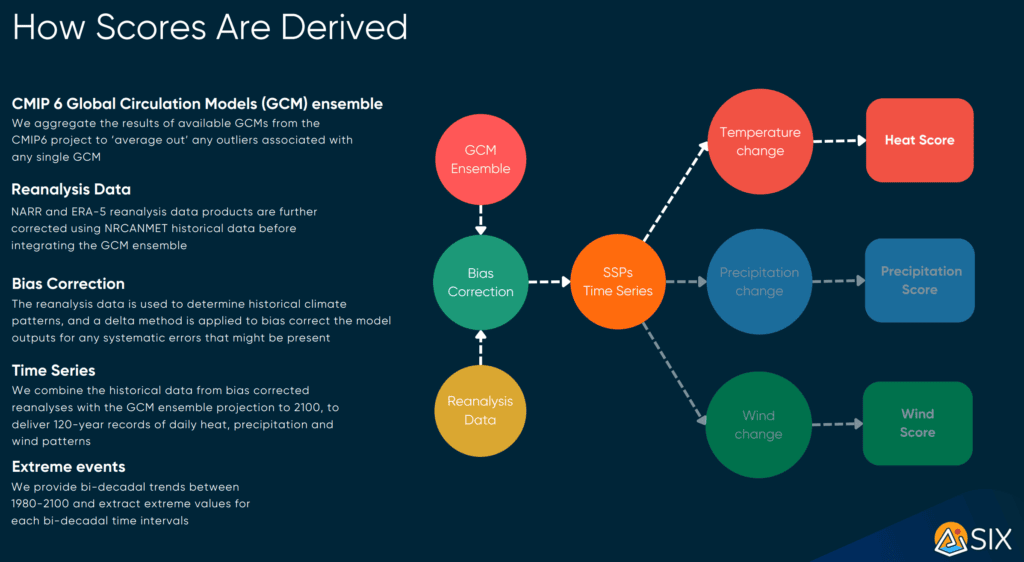The Precipitation Score for Canada, powered by AISIX uses a downscaled, bias corrected, multi-model ensemble for maximum daily precipitation by mid-century for a middle-of-the-road climate change scenario (SSP2). The dataset simulates future precipitation at a 10km scale.
AISIX determines the maximum precipitation distribution across Canada and assigns risk scores based on the Environment Canada weather warning system, adjusted for geographic region.
The data adequately captures future trends in regional precipitation patterns, but further extremes should be expected at finer scales. This is because the operating resolution of climate model products combines and averages intricate terrain and characteristics of storm formation such as interactions with mountainous terrain into larger grid cells. The SSP2 climate change scenario assumes that socio-economic trends do not shift significantly from current global patterns. This climate change scenario represents a middle ground between a low-warming future characterized by proactive societal mitigation of a changing climate, and a high-warming future that does not mitigate climate change in pursuit of socioeconomic development.

Precipitation Fact: when assessing precipitation risk to buildings, a combination of how fast precipitation accumulates, how fast it drains away from the property, and how long the precipitation lasts provides the clearest picture of the current hazard.
AISIX Score
To enhance the accuracy and transparency of the probabilities, AISIX has implemented a classification system consisting of five distinct levels: 1 to 5 based on daily maximum precipitation in millimetres per day (mm/day):

FAQs
- What is a preciptation risk score?
AISIX‘s precipitation score represents how high precipitation will be by 2050 for a given location compared the average for Canada. The higher the score, the higher the maximum precipitation by mid-century. - How often is the precipitation risk score updated?
Precipitation risk scores are typically updated annually to reflect new data and environmental changes. - Is my property’s precipitation risk score based on current weather conditions?
While the base score incorporates historical and geographical data, it may not reflect real time conditions. - Can the precipitation risk score change over time?
Yes, the score can change due to factors like climatic changes and improvements in risk assessment technologies. Regular updates incorporate these changes to keep the score as accurate as possible. - Who can I contact for more detailed information about my property’s precipitation risk?
For more detailed information, contact info@aisix.ca. - What should I do if I disagree with my precipitation risk score?
If you disagree with your score, you can request a review or reassessment.
Climate Data Disclaimer
The climate data provided on this website is intended to furnish users with general information on the potential impacts of climate-related factors on property values and conditions. This data is
derived from various sources, which may include governmental meteorological agencies, climate change models, and other third-party data providers.
Accuracy and Limitations: AISIX endeavors to offer up-to-date and accurate climate data; however, due to the inherent variability of climate and weather patterns, we cannot guarantee the
absolute accuracy or completeness of this data. The information is provided "as is" without warranty of any kind, either express or implied.
Not a Substitute for Professional Advice: The climate data presented should not be construed as professional real estate, legal, or financial advice. It is intended for informational purposes only,
and should not be relied upon for making decisions regarding real estate transactions or investments. We strongly recommend consulting with a professional real estate advisor or a climate
resilience expert to obtain specific advice tailored to your individual circumstances.
No Liability: Under no circumstances will AISIX be liable for any direct, indirect, incidental, special, consequential, or exemplary damages arising out of or in connection with the use of the climate
data provided. This includes, but is not limited to, damages for loss of profits, goodwill, use, data, or other intangible losses.
Changes and Updates: The climate data on this website may be updated periodically. They reserve the right to make changes or updates at any time without prior notice.
Contact Us: If you have any questions or concerns about the climate data or its implications for a specific property, please contact the AISIX support team at: info@aisix.ca
By accessing and using the climate data on this website, you acknowledge and agree to the terms set forth in this disclaimer.